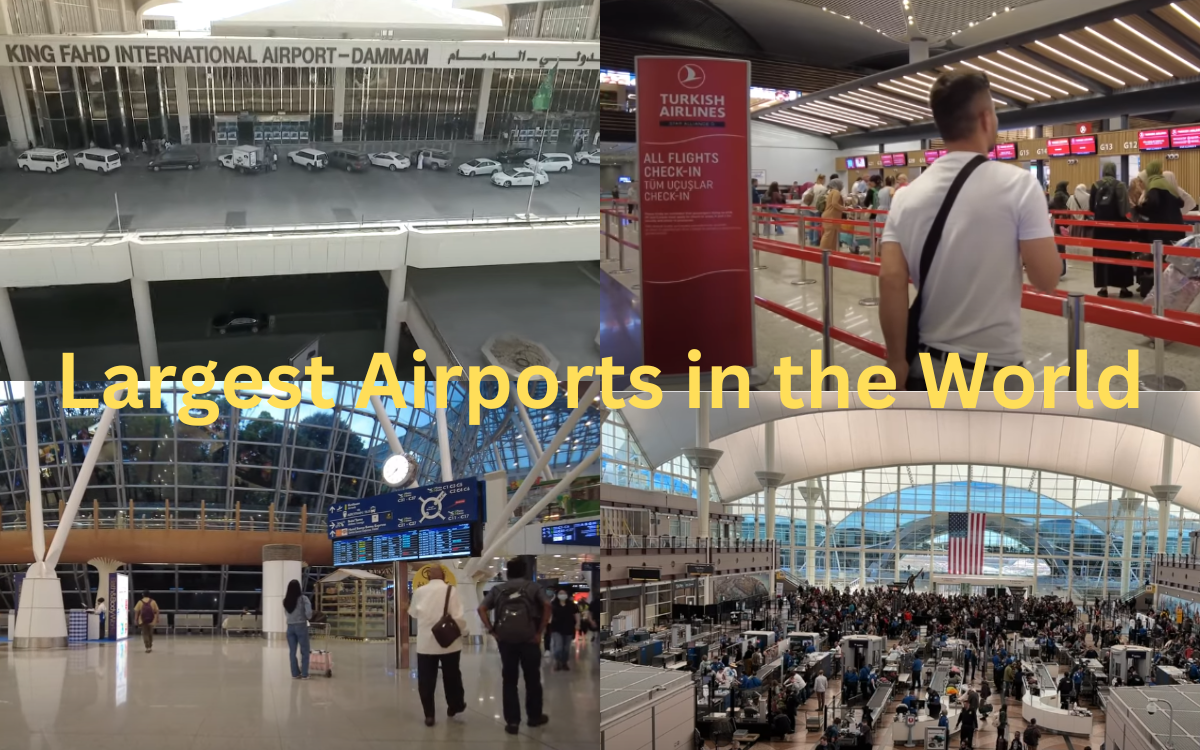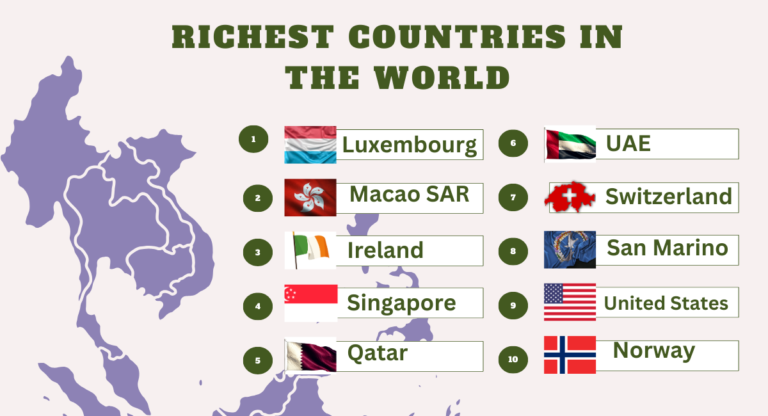Top 11 Largest Airports in the World in 2024
When you think of a “big” airport, you probably picture a busy hub with tons of passengers coming and going. But what if size isn’t measured by people but by land? That’s where things get interesting! The largest airports in the world aren’t always the busiest. Some are massive stretches of land, hoping for future growth. Others have fascinating histories explaining their enormous size.
For example, Atlanta Hartsfield-Jackson, known as the world’s busiest airport by passenger count, occupies a relatively modest 4,700 acres, excluding it from the largest airports by area. In contrast, Denver International Airport, the largest in the United States, spans a staggering 53 square miles, dwarfing even heavily trafficked hubs like Chicago O’Hare.
Several of the world’s largest airports are found in the southern and western United States, where developers had the foresight to secure extensive land areas early on. This foresight allows for potential expansion and acts as a buffer zone, crucial for maintaining operations amid growing urban environments.
So, which airports make up the world’s largest list? This guide presents a ranking based on total land area, drawing from various sources, including airport publications, local government data, and records like those from Guinness World Records.
Let’s begin!
A List of the World’s 11 Largest Airports
Here is the list of the 11 Largest Airports in the World.
- King Fahd International Airport — Dammam, KSA
- Denver International (DEN) — Denver, CO, USA
- Kuala Lumpur International Airport (KUL) — Malaysia
- Istanbul Airport (IST) — Turkey
- Dallas/Fort Worth International (DFW) — Dallas, TX, USA
- Southwest Florida International Airport in Fort Myers, Florida (RSW)
- Orlando International (MCO) — Orlando, FL, USA
- Washington Dulles International (IAD) — Washington D.C., USA
- Beijing Daxing International (PKX) — Beijing, China
- George Bush Intercontinental (IAH) — Houston, TX, USA
- Shanghai Pudong International (PVG) — Shanghai, China
1. King Fahd International Airport — Dammam, KSA
According to Guinness World Records, King Fahd International Airport (DMM) in Saudi Arabia is the world’s largest airport by land area. Covering an astonishing 300 square miles, it surpasses the total land area of neighboring Bahrain. This massive size is attributed to its history as a former American military base.
Despite its large size, DMM is merely Saudi Arabia’s third busiest airport, receiving approximately 10 million people each year. It is located about 20 miles northwest of downtown Dammam and acts as a hub for airlines, including Saudi (Saudi Arabian Airlines), Emirates, and Qatar Airways.
The airport features two main terminals: one for international flights and one for domestic flights. Additionally, there is a third terminal exclusively for the royal family, VIPs, and government officials. This Royal Terminal spans 177,000 square feet. The airport also boasts an onsite mosque that can accommodate up to 2,000 worshippers simultaneously, a residential community housing over 3,000 people, and a greenhouse used for onsite landscaping.
Also Explore: 15 Largest Airlines in the World
2. Denver International (DEN) — Denver, CO, USA
While Atlanta holds the title of the busiest airport in the United States, Denver International Airport (DEN) is the largest by land area, covering an impressive 53 square miles. When the airport was constructed 25 miles from downtown Denver in the mid-1990s, locals were initially displeased with the remote location. However, this placement allowed for significant future expansion. For visitors planning to explore Denver without renting a car, the light rail offers a convenient and cost-effective way to reach downtown. Taxis and rideshares can be pricey over such a distance.
DEN is renowned for its distinctive roof, which is designed with white, tent-like structures that evoke the snow-capped Rocky Mountains to the west. Known locally as DIA, the airport features three interconnected concourses—A, B, and C—linked by an efficient airport train system.
Due to Denver’s prone-to-winter weather, thick fog, and heavy winds, flight delays are not uncommon. Fortunately, DIA offers plenty to keep travelers entertained during long layovers. The airport boasts an impressive array of dining options, where you can savor local flavors at spots like the Boulder Beer Tap House, Rocky Mountain Chocolate Factory, Breckenridge Brewery, and the Denver Chop House. Additionally, there are major airline lounges and even a spa in Concourse B to help you unwind before your flight.
3. Kuala Lumpur International Airport (KUL) — Malaysia
Kuala Lumpur International Airport (KUL) is Malaysia’s primary international gateway and ranks among the largest airports in the world by land area. Located 28 miles south of Kuala Lumpur, the capital city, KUL spans an impressive 39 square miles, making it about 1.5 times the size of Dallas-Fort Worth (DFW). Though KUL doesn’t match DFW’s daily flight volume of nearly 1,800 flights, it boasts a substantial 3,000 flights per week.
KUL features two main terminals, KLIA1 and KLIA2, each functioning as a standalone airport. The entrances to these terminals are seven miles apart but are conveniently connected by the KLIA Aerotrain, a three-minute rail service. Terminal One is the hub for Malaysia’s national carrier, Malaysia Airlines, and hosts international airlines such as Singapore Airlines, Japan Airlines, KLM, and British Airways. Terminal Two is dedicated to low-cost carriers, including AirAsia and AirAsia X.
The airport’s expansive footprint, where once agricultural land was, reflects its capacity for future growth and development. With its significant size and modern facilities, KUL continues to be a key player in global aviation, providing seamless connectivity and services to millions of passengers annually.
4. Istanbul Airport (IST) — Turkey
Covering an impressive 30 square miles, Istanbul Airport is one of the world’s largest airports, officially opening its doors in 2019. It is now the fourth largest airport globally, boasting a capacity to serve up to 200 million passengers each year. This vast facility features a single, expansive terminal divided into five concourses. Concourse A, B, D, and F handle international flights, while Concourse G and part of Concourse F are dedicated to domestic travel.
The airport offers a number of dining options. For quick bites, travelers can visit “Burger King,” while “Tadında Anadolu” provides a taste of traditional Turkish cuisine. For local delicacies, “Selamlique” is a popular choice.
Passengers can also enjoy extensive shopping opportunities, with nearly 600,000 square feet of retail space that feels like a large mall. For those needing rest, the airport’s “YOTEL” offers comfortable, modern accommodations. Additional amenities include lounges with spa services, business zones with high-speed Wi-Fi, and meeting spaces, ensuring a pleasant and productive experience for all travelers passing through this massive hub.
5. Dallas/Fort Worth International (DFW) — Dallas, TX, US
Dallas/Fort Worth International Airport (DFW), seen from above, spans an impressive 27 square miles, making it one of the largest airports globally. While it no longer holds the title of the world’s largest airport—a distinction it enjoyed when it first opened in 1974—it remains in the top five. The airport is so extensive that it has its own zip code and city designation. Additionally, DFW is one of the busiest airports in the world, accommodating tens of millions of passengers each year across its five terminals and 168 gates.
A unique feature of DFW is its numerous security checkpoints scattered throughout each terminal. These checkpoints significantly reduce wait times and make the security process more efficient. This setup contrasts sharply with airports like Denver, where security lines can be much longer.
While security lines move quickly, navigating between terminals for connecting flights can take a bit more time. The airport’s Skylink, a free light-rail service within the secure area, connects all five terminals and runs every two minutes, helping passengers make tight connections.
DFW is a major hub for all major airlines, with American Airlines being the primary carrier, using it as their main hub. The airport also serves as a key junction for connecting flights, playing a crucial role in both domestic and international travel.
Also Read: 11 Biggest Shopping Malls in America
6. Southwest Florida International Airport in Fort Myers, Florida (RSW)
Located in Fort Myers, Florida, Southwest Florida International Airport (RSW) may not have the same bustling passenger numbers as some of its counterparts, handling approximately 10 million travelers last year. However, its significance stretches far beyond mere statistics. Serving as the primary gateway to Florida’s southwest region, RSW plays a crucial role in connecting travelers to various captivating destinations, including the vibrant communities of Cape Coral-Fort Myers, the scenic shores of Naples and Marco Island, and the charming allure of Punta Gorda.
What truly sets RSW apart, however, is its remarkable landmass. Spanning an expansive 21.2 square miles, it claims the title of the third-largest airport in the United States by land area, trailing only behind Denver and DFW. This sizable footprint sparks curiosity—what accounts for such grandeur? The answer lies in a harmonious balance between progress and preservation.
A significant portion of RSW’s land—approximately 6,000 acres—is dedicated to the conservation of protected swamp lands, meticulously set aside for environmental preservation purposes. This conscientious effort underscores RSW’s commitment to environmental stewardship, ensuring that alongside its role as a bustling transportation hub, it remains a sanctuary for wildlife and natural habitats.
7. Orlando International (MCO) — Orlando, FL, USA
Orlando International Airport (MCO), with 20.7 square miles, is the bustling aerial gateway to central Florida’s vibrant tourism landscape. It is conveniently situated a mere six miles from the heart of downtown Orlando. Renowned worldwide for its proximity to the region’s iconic theme parks, MCO serves as the primary point of entry for travelers seeking the excitement and adventure that defines this globally beloved destination.
With an extensive network of scheduled nonstop flights connecting it to 48 international destinations, MCO serves as a crucial link for tourists from every corner of the globe, eager to experience the magic of Central Florida’s family-friendly attractions. Last year marked a significant milestone with the inauguration of Terminal C, a monumental $2.8 billion investment geared towards expanding capacity and elevating the passenger experience to new heights.
Additionally, the recent introduction of the Brightline high-speed rail line, complete with a dedicated station at the airport, has further revolutionized transportation connectivity, offering travelers seamless access to Orlando’s bustling cityscape and beyond. As MCO continues to evolve and innovate, it solidifies its position not just as an airport but as a vital conduit connecting visitors to the enchanting wonders of central Florida.
8. Washington Dulles International (IAD) — Washington D.C., USA
Washington Dulles International Airport (IAD), spanning an impressive 18.7 square miles, emerged amidst rural Northern Virginia in the early 1960s. Initially, its extensive land raised eyebrows among Beltway insiders, situated approximately 30 miles from the nation’s capital. Despite skepticism, the airport’s striking Eero Saarinen-designed terminal soon became an architectural marvel, symbolizing innovation and modernity.
Today, Dulles Airport has transcended its humble beginnings to become a pivotal hub for United Airlines, serving as a prominent East Coast gateway with direct connections to 61 international destinations. While reaching the airport from the district may still require a nearly hour-long drive, recent expansions of the Metro line offer a convenient public transit alternative, bridging the gap between urban centers and air travel accessibility.
This journey from skepticism to significance underscores Dulles Airport’s evolution as a vital conduit connecting Washington, D.C., to the global stage, embodying the spirit of progress and connectivity that defines the nation’s capital.
9. Beijing Daxing International (PKX) — Beijing, China
Beijing Daxing International Airport (PKX), with an area of 18 square miles, proudly proclaims itself as “the biggest airport in the world” on its website, a statement that, while not entirely accurate, firmly positions it within the realm of mega-airports. Its most striking feature is undoubtedly its colossal single-building terminal, which spans a staggering 7.5 million square feet—an area equivalent to 98 soccer fields. This architectural marvel, designed by the late renowned architect Zaha Hadid, serves as a testament to human ingenuity and engineering prowess.
Opened to the public in 2019, PKX represents a significant milestone in China’s aviation history, signaling the nation’s commitment to advancing its infrastructure on a global scale. With ambitions as vast as its physical footprint, the airport aims to accommodate a staggering 100 million travelers annually by the year 2040, a feat that requires meticulous planning and strategic foresight.
To meet this ambitious target, extensive expansion plans are underway, not only to enhance passenger facilities but also to increase the number of runways from the current four to seven. These efforts underscore China’s dedication to fostering economic growth and connectivity through aviation, solidifying PKX’s position as a vital hub in the global transportation network and shaping the future of air travel for generations to come.
10. George Bush Intercontinental (IAH) — Houston, TX, USA
George Bush Intercontinental Airport (IAH) in Houston stands as a witness to the city’s grand vision and forward-thinking ethos. It dates back to the late 1950s when civic leaders purchased land for what would become a crucial aviation hub. Over the ensuing decades, IAH has steadily expanded its real estate holdings, growing to its present size of 17.1 square miles. This expansion mirrors Houston’s ascent as a major player on the global stage, with IAH serving as a pivotal gateway for travelers from around the world.
With five strategically positioned runways, IAH boasts the capacity to handle a high volume of long-distance flights, particularly to destinations in Latin America and beyond. As a primary hub for United Airlines, the airport plays a central role in connecting passengers to diverse destinations across the globe.
Looking to the future, IAH remains committed to enhancing its infrastructure and passenger experience. Notably, plans are underway for the construction of a new combined Terminal D and E, slated for completion by early 2025. This ambitious project reflects Houston’s ongoing dedication to innovation and progress, ensuring that IAH remains at the forefront of aviation excellence and continues to elevate the city’s prominence on the world stage.
11. Shanghai Pudong International (PVG) — Shanghai, China
Shanghai Pudong International Airport (PVG) in China embodies the country’s ambitious drive for modernization and global connectivity. Established in the early 1990s to meet the burgeoning demands of Shanghai’s rapid economic growth, PVG has since evolved into a bustling aviation hub of immense proportions. Spanning an area of 15.4 square miles, PVG serves as a vital gateway to Shanghai, one of the world’s most dynamic metropolises.
With its state-of-the-art facilities and strategic location, PVG caters to a vast array of domestic and international flights, facilitating seamless travel experiences for millions of passengers annually. As a key hub for numerous major airlines, PVG plays a crucial role in connecting Shanghai to destinations across Asia and beyond.
Looking ahead, PVG continues to innovate and expand, with ongoing efforts to enhance its infrastructure and services. With its steadfast commitment to excellence, PVG remains poised to shape the future of air travel in China and beyond, solidifying its status as a global aviation powerhouse.
Table Ranking the Largest Airports in the World in Terms of Area
| Rank | Airport | Area |
| 1 | King Fahd International Airport in Dammam, KSA | 300 square miles |
| 2 | Denver International (DEN) — Denver, CO, USA | 53 square miles |
| 3 | Kuala Lumpur International Airport (KUL) — Malaysia | 39 square miles |
| 4 | Istanbul Airport (IST) — Turkey | 30 square miles |
| 5 | Dallas/Fort Worth International (DFW) — Dallas, TX, US | 27 square miles |
| 6 | Southwest Florida International Airport in Fort Myers, Florida (RSW) | 21.2 square miles |
| 7 | Orlando International (MCO) — Orlando, FL, USA | 20.7 square miles |
| 8 | Washington Dulles International (IAD) — Washington D.C., USA | 18.7 square miles |
| 9 | Beijing Daxing International (PKX) — Beijing, China | 18 square miles |
| 10 | George Bush Intercontinental (IAH) — Houston, TX, USA | 17.1 square miles |
| 11 | Shanghai Pudong International (PVG) — Shanghai, China | 15.4 square miles |
Final Words
In summary, the largest airports in the world continue to alter the travel experience, surpassing their status as mere transit points to become destinations in and of themselves. From the bustling terminals of Hartsfield-Jackson Atlanta International Airport to the tranquil surroundings of Changi Airport in Singapore, each airport provides a distinct blend of efficiency, innovation, and aesthetic appeal.
As we look at the architectural wonders, technological innovations, and thoughtful facilities found within these aviation hubs, it becomes clear that the journey is an important part of the destination. Whether starting on a new trip or returning home, the airports we pass through leave an indelible impression on our memory, serving as portals to exploration, connection, and discovery in our ever-shrinking world of travel.
FAQs
What Airport Holds the Title of the Busiest in the World?
Hartsfield-Jackson Atlanta International Airport, situated in Atlanta, Georgia, is the world’s busiest airport, with more than 107 million passengers passing through its terminals in a typical year.
What Are Some of the Top-Rated Airports in the World?
Singapore Changi Airport is renowned for its amenities, including a rooftop pool, dedicated gaming rooms, and nap facilities, making it ideal for layovers. Other notable airports offering a wide range of dining options and activities include Dubai International Airport, Hong Kong International Airport, and Vancouver Airport.
What Is the World’s Smallest Airport?
The title of the world’s smallest airport belongs to Juancho E Yrausquin Airport, situated in Saba, Caribbean Netherlands.
Which Airport Is Larger, Istanbul or Dubai?
Istanbul Airport in Turkey is indeed larger in physical size than Dubai International Airport in the UAE. Officially known as Istanbul Airport (IST), it is one of the largest airports globally, boasting extensive terminals and runways.
Which Country Is Home to the Most Stunning Airport?
Changi Airport in Singapore stands out as a beacon of architectural marvels. Its Jewel Changi, featuring a breathtaking 40-meter-high waterfall enveloped by 2,000 lush trees, captures the essence of natural splendor. Moreover, each terminal has its unique attractions—a butterfly garden in Terminal 3, a sunflower garden in Terminal 2, and a cactus garden in Terminal 1—adding to the airport’s beauty and providing travelers with unforgettable experiences.

I’m Sophia Jones, an adventurer at heart from New York City, USA. I live for travel and exploration, always eager to discover new places, meet fascinating people, and try out diverse cuisines. Over the past few years, I’ve traveled to numerous countries, immersing myself in different cultures and creating unforgettable memories.






